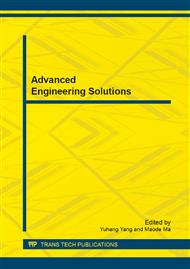[1]
Alok Mittal, Arti Malviya, Dipika Kaur, Jyoti Mittal, Lisha Kurup, Studies on the adsorption kinetics and isotherms for the removal and recovery of Methyl Orange from wastewaters using waste materials[J]. Journal of Hazardous Materials Vol. 148 (2007).
DOI: 10.1016/j.jhazmat.2007.02.028
Google Scholar
[2]
W. Azmi, R.K. Sani, U.C. Banerjee, Biodegradation of triphenylmethane dyes, Enzyme Microb. Technol Vol. 22 (1998), p.185.
DOI: 10.1016/s0141-0229(97)00159-2
Google Scholar
[3]
J. Wu, M.A. Eiteman, S.E. Law, Evaluation of membrane filtration and ozonation processes for treatment of reactive dye wastewater. J. Environ. Eng Vol. 124 (1998), p.272.
DOI: 10.1061/(asce)0733-9372(1998)124:3(272)
Google Scholar
[4]
S.H. Lin, C.F. Peng, Continuous treatment of textile waste water by combined coagulation electrochemical oxidation and activated sludge, Water Res Vol. 30 (1996), p.587.
DOI: 10.1016/0043-1354(95)00210-3
Google Scholar
[5]
J. Sun, L. Qiao, S. Sun, G. Wang, Photocatalytic degradation of Orange G on nitrogen-doped TiO2 catalysts under visible light and sunlight irradiation, J. Hazard. Mater Vol. 155 (2008), p.312.
DOI: 10.1016/j.jhazmat.2007.11.062
Google Scholar
[6]
A.G. Vlyssides, M. Loizidou, P.K. Karlis, A.A. Zorpas, D. Papaioannou Electrochemical oxidation of a textile dye wastewater using a Pt/Ti electrode. J. Hazard. Mater Vol. 70 (1999), p.41–52.
DOI: 10.1016/s0304-3894(99)00130-2
Google Scholar
[7]
M.J. Martin, A. Artola, M.D. Balaguer, M. Rigola, Activated carbons developed from surplus sewage sludge for the removal of dyes from dilute aqueous solution, Chem. Eng. J Vol. 94 (2003), p.231.
DOI: 10.1016/s1385-8947(03)00054-8
Google Scholar
[8]
G. Annadurai, R.S. Juang, D.J. Lee. Factorial design analysis for adsorption of dye on activated carbon beads incorporated with calcium alginate. Adv. Environ. Res Vol. 6 (2002), p.191.
DOI: 10.1016/s1093-0191(01)00050-8
Google Scholar
[9]
S. Chakraborty, S. De, S. DasGupta, J.K. Basu, Adsorption study for the removal of a basic dye: experimental and modeling. Chemosphere Vol. 58 (2005), p.1079.
DOI: 10.1016/j.chemosphere.2004.09.066
Google Scholar
[10]
M.M. Nassar, M.S. El-Geundi, Comparative cost of colour removal from textile effluents using natural adsorbents, J. Chem. Tech. Biotech Vol. 50 (1991) , p.2574.
DOI: 10.1002/jctb.280500210
Google Scholar
[11]
K.S. Cho u, J.C. Tsai, C.T. Lo, The adsorption of Congo red and vacuum pump oil by rice hull ash, Bioresour. Technol Vol. 78 (2001) p.217.
DOI: 10.1016/s0960-8524(00)00116-4
Google Scholar


